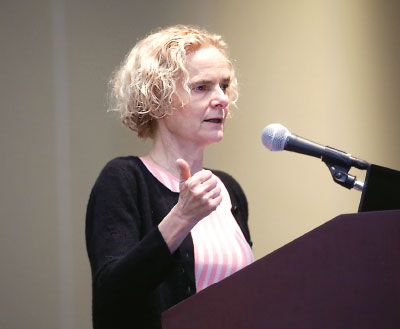The rise of teen nicotine and THC vaping and the emerging links between cannabis and psychoses are two of the recent substance use trends in the United States that National Institute on Drug Abuse (NIDA) Director Nora Volkow, M.D., plans to tackle during a presentation at APA’s 2020 Annual Meeting in Philadelphia.
In an interview with Psychiatric News, Volkow noted that the marked increase in vaping among U.S. youth over the past few years is worrisome because vaping is not just another way to intake tobacco or cannabis. “These e-cigarette devices are designed to deliver a high content of nicotine or THC [tetrahydrocannabinol, the primary psychoactive component of cannabis] in a short amount of time,” she told Psychiatric News. “This rapid delivery results in a much greater likelihood of becoming addicted to cannabis or nicotine.”
Teens who vape nicotine may also be more likely to become addicted to other substances, as nicotine is known to make the rewarding effects of other drugs more powerful, she said.
Though nicotine and cannabis are popular topics of media interest, Volkow also plans to discuss the growing numbers of people dying from misuse of stimulants. Volkow told Psychiatric News that the most recent population data have shown that overdose deaths from cocaine and methamphetamine are almost as high as those from the synthetic opioid fentanyl. As stimulants become more popular, it is likely that new synthetic stimulants will emerge just as has occurred for opioids, she added.
“I predict that in the coming decade, we will continue to see an increase in the use of synthetic drugs, which are designed to have greater potency than that of natural drugs,” Volkow said. “New types of synthetic drugs, in combination with new delivery devices such as the new generation of electronic cigarettes, will maximize the rewarding effects of drugs.”
Brain Development
In the face of such challenges with drugs of misuse, a better understanding of how the brain develops may lead to advances in the prevention and treatment of substance use disorders, Volkow said. She will also discuss some of NIDA’s current initiatives in the area of neurodevelopment during her lecture, including updates from the ongoing Adolescent Brain Cognitive Development (ABCD) Study, as well as the planned Healthy Brain and Child Development (HBCD) Study. The ABCD Study is a landmark collaborative effort between many institutes at the National Institutes of Health to measure brain changes in children from age 10 to 20. The HBCD Study is a new proposed initiative that will follow the brain development of newborns, including those born to mothers who used opioids during pregnancy, until they reach early adolescence.
“Monitoring the full range of childhood development is crucial to achieve success in treating brain disorders,” Volkow said. Data from HBCD will provide clues not only for developmental disorders such as autism that manifest early in youth, but also disorders such as depression that typically emerge in adolescence. “The risk factors that signal the onset of depression are present early in youth,” Volkow explained.
From NIDA’s perspective, a knowledge of these trajectories is important given the strong connections between mental illness and substance use. For example, Volkow will discuss the emerging links between cannabis use, psychoses, and depression.
“We associate cannabis use with a higher risk of psychosis, but its association with depression and suicidality, which has been noted by several epidemiological studies, has been much less investigated.”
Currently, it’s unclear which direction this association goes: whether teens with incipient depression begin using cannabis to self-medicate or whether cannabis use exacerbates existing risk factors to trigger depression onset (or potentially both). “If we better understand the trajectories of mental illness and substance use, we can intervene earlier,” she said. ■
Volkow’s lecture, “Opportunities and Challenges in Addiction Research,” will be held on Monday, April 27, from 1 p.m. to 2:30 p.m.

